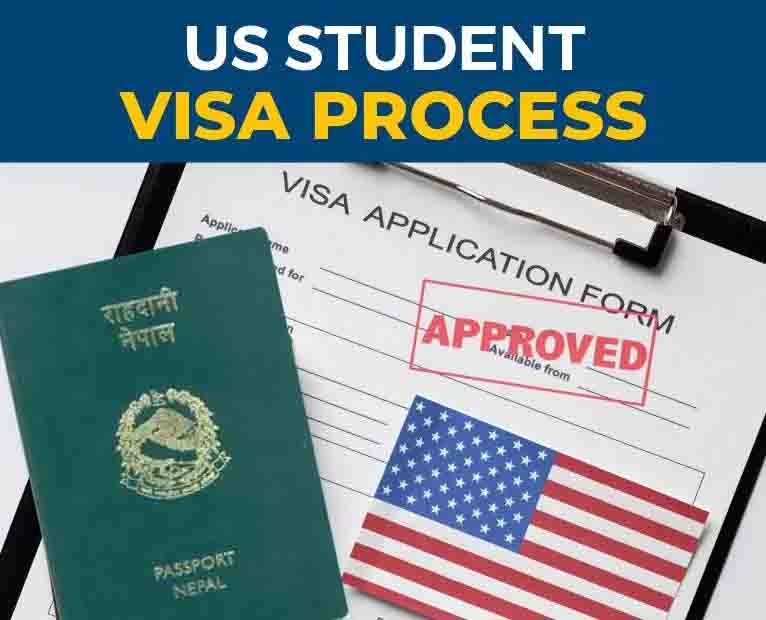USA Study Visa: The USA continues to be the top choice for students planning to study abroad. If you are among the few who aspire and have already got admission into your aspired university, applying for Student Visa is the next important step to realizing your Study in the USA dream.
So is it easy to get a study visa in the USA is one major query which arises among international students, and the answer to this question is that it’s not difficult to get a student visa in the US especially for Nepalese students till the time their paperwork and applications are complete and they ace their interviews. US study visa includes three broad types – one for studying at the university level, the second is the exchange level program visa and the third one is for vocational education, that is, F, J and M student visas in the US respectively. The timeline for application assessment for each of these student visas varies.
F1 Student Visa
Students applying for a program that requires more than 18 hours of study in a week require an F1 visa in USA. This includes all undergraduate programs as well as graduate programs like MS in the US or MBA in the USA.
Spouses or children accompanying F-1 visa recipients will travel on an F-2 visa. Please note that spouses are not able to work but may accompany and/or apply for their own visa to the U.S. to work or study.
Cost of Student Visa in the USA
There are two fees associated with for F1 student visa for the USA
- SEVIS fee which is at present at $350, US student visa fees in Nepalese rupees is approximately Nrs. 46549.
- Visa Application Fee (MRV Fee) which is at present $160 equals Nrs. 21279.
*Spouses and dependents do not need to pay the SEVIS fee if they are going to the U.S. on F-2 or J-2 visas.
**MRV is Machine Readable Visa Fee, or in layman’s terms is an application fee. In order to appear for a student visa interview to study in the US, it is mandatory for international students to carry along with them the MRV receipt.
Documents Required for F1 Student Visa Application:
USA Study Visa Process: You need the mandatory documents along with supporting documents of financial and academic records. Make sure you refer to this checklist before going to the consulate for the visa interview.
- A valid passport with a validity date of at least six months beyond your period of stay.
- A printed copy of DS-160, the online application form
- SEVIS Fee Receipt
- Interview appointment letter (original and copy)
- Form I-20 sent by the college (where you are going to study)
- Visa fees payment confirmation receipt
- Bank statement for at least three years showing that you have enough assets to pay for the first year (could be of parent or guardian)
- Pay/salary slips
- Original mark sheets/provisional certificates
- Score sheet of exams like TOEFL or IELTS as ELP proofs along with either ACT or SAT for UG admissions or GMAT or GRE for PG admissions.
- Financial Documents are required to show financial strength to support education in the USA.
For the USA, students need to show proof of the number of funds they need to cover the first year’s total expenses. It includes tuition fees, living expenses, and other expenses (like books). Apart from this, students also need to show proof of the readily available funds for the rest of the tenure of their education.
Evidence of Financial Resources Required for F1 Visa:
- Tax returns for the past 3 years
- Bank statements/passbook for the past 3 years
- Original pay/salary slips and letters of employment
- Statement from certified CA
- Scholarship letter (If the applicant has received it)
- The loan approval letter by the bank or the concerned authority
How to Apply for US Student Visa (F1 Visa)?
There are several steps to apply for a USA Study Visa:
- Your visa process starts when you receive Form I-20 from your college. Though you can pay the SEVIS fee anytime during the application, it is strongly recommended that you pay the SEVIS I-901 fee before you start your US visa application.
- After paying the SEVIS fee and getting a receipt, you can apply for a DS-160 visa form. It is an online application form.
- Print the application form confirmation page to bring to your interview.
- Schedule a Biometric appointment and Interview appointment.
- For the Biometric appointment, you will be required to appear in person to get your photograph clicked for the visa and get your fingerprints scanned.
- At the Personal interview, the interviewer will ask you questions about your choice, of course, college, finances, and intent of coming back. If s/he is convinced, they will keep your passport with them to get the visa stamped.
Remember, F1 student visas can be issued up to 120 days before the starting date of your course of study. However, you will not be allowed to enter the United States on F1 status earlier than 30 days before your start date.
Dependents
- Spouses and children under the age of 21 who wish to accompany the applicant in the US for the duration of his or her stay require F2 or M2 visas. A spouse on F2 status cannot enrol for a full course of study but can attend classes that are vocational or recreational in nature like pursuing a hobby or interest, such as cooking or tennis. Children on F2 status are allowed to attend elementary, middle, or high school as full-time students. They may not enrol in a full-time course of study at a college or university.
- The spouse and children of students cannot accept employment at any time during their stay period on the F2 Visa.
Additional Information
- F1 visa holders are eligible for up to 12 months of OPT (optional practical training) on completion of graduation. That means you can work for a year after you finish your studies. STEM can apply for 24 months of OPT extension.It is a temporary employment permission giving students the opportunity to gain practical experience in their field of study. After that, you will be required to apply for a work visa if you have to continue working in the US. You can remain in the US up to 60 days after the completion of your course even if you don’t have a job offer or haven’t applied for OPT.
Intakes in USA:
- There are three main intakes in USA: Summer, Spring and Fall. Spring intake happens in January, Summer in May, and Fall intake starts in September.

